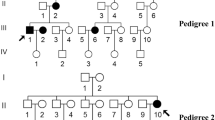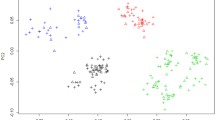Abstract
Mitochondrial diabetes originates mainly from mutations located in maternally transmitted, mitochondrial tRNA-coding genes. In a genetic screening program of type 2 diabetes conducted with a Chinese Han population, we found one family with suggestive maternally transmitted diabetes. The proband’s mitochondrial genome was analyzed using DNA sequencing. Total 42 known nucleoside changes and 1 novel variant were identified, and the entire mitochondrial DNA sequence was assigned to haplogroup M11b. Phylogenetic analysis showed that a homoplasmic mutation, 10003T>C transition, occurred at the highly conserved site in the gene encoding tRNAGly. Using a transmitochondrial cybrid cell line harboring this mutation, we observed that the steady-state level of tRNAGly significantly affected and the amount of tRNAGly decreased by 97 %, production of reactive oxygen species was enhanced, and mitochondrial membrane potential, mtDNA copy number and cellular oxygen consumption rate were remarkably decreased compared with wild-type cybrid cells. The homoplasmic 10003T>C mutation in the mitochondrial tRNAGly gene suggested to be as a pathogenesis-related mutation which might contribute to the maternal inherited diabetes in the Han Chinese family.





Similar content being viewed by others
References
Anderson S, Bankier AT, Barrell BG, de Bruijn MH, Coulson AR, Drouin J, Eperon IC, Nierlich DP, Roe BA, Sanger F, Schreier PH, Smith AJ, Staden R, Young IG (1981) Sequence and organization of the human mitochondrial genome. Nature 290:457–465
Levinger L, Mörl M, Florentz C (2004) Mitochondrial tRNA 3′ end metabolism and human disease. Nucleic Acids Res 32:5430–5441
Schon EA, Dimauro S, Hirano M (2012) Human mitochondrial DNA: roles of inherited and somatic mutations. Nat Rev Genet 13:878–890
Majamaa K, Moilanen JS, Uimonen S, Remes AM, Salmela PI, Kärppä M, Majamaa-Voltti KA, Rusanen H, Sorri M, Peuhkurinen KJ, Hassinen IE (1998) Epidemiology of A3243G, the mutation for mitochondrial encephalomyopathy, lactic acidosis, and strokelike episodes: prevalence of the mutation in an adult population. Am J Hum Genet 63:447–454
van den Ouweland JM, Lemkes HH, Ruitenbeek W, Sandkuijl LA, de Vijlder MF, Struyvenberg PA, van de Kamp JJ, Maassen JA (1992) Mutation in mitochondrial tRNA(Leu)(UUR) gene in a large pedigree with maternally transmitted type II diabetes mellitus and deafness. Nat Genet 1:368–371
Gerbitz KD, van den Ouweland JM, Maassen JA, Jaksch M (1995) Mitochondrial diabetes mellitus: a review. Biochim Biophys Acta 1271:253–260
Lu J, Wan D, Li R, Li W, Ji J, Zhao J, Ye W, Yang L, Qian Y, Zhu Y, Guan MX (2006) Maternally transmitted diabetes mellitus associated with the mitochondrial tRNA(Leu(UUR)) A3243G mutation in a four-generation Han Chinese family. Biochem Biophys Res Commun 348:115–119
Suzuki Y, Suzuki S, Hinokio Y, Chiba M, Atsumi Y, Hosokawa K, Shimada A, Asahina T, Matsuoka K (1997) Diabetes associated with a novel 3264 mitochondrial tRNA(Leu)(UUR) mutation. Diabetes Care 20:1138–1140
Tsukuda K, Suzuki Y, Kameoka K, Osawa N, Goto Y, Katagiri H, Asano T, Yazaki Y, Oka Y (1997) Screening of patients with maternally transmitted diabetes for mitochondrial gene mutations in the tRNA[Leu(UUR)] region. Diabet Med 14:1032–1037
Hao H, Bonilla E, Manfredi G, DiMauro S, Moraes CT (1995) Segregation patterns of a novel mutation in the mitochondrial tRNA glutamic acid gene associated with myopathy and diabetes mellitus. Am J Hum Genet 56:1017–1025
Kameoka K, Isotani H, Tanaka K, Azukari K, Fujimura Y, Shiota Y, Sasaki E, Majima M, Furukawa K, Haginomori S, Kitaoka H, Ohsawa N (1998) Novel mitochondrial DNA mutation in tRNA(Lys) (8296A– > G) associated with diabetes. Biochem Biophys Res Commun 245:523–527
Maassen JA (2002) Mitochondrial diabetes: pathophysiology, clinical presentation, and genetic analysis. Am J Med Genet 115:66–70
Maassen JA, ‘T Hart LM, Van Essen E, Heine RJ, Nijpels G, Jahangir Tafrechi RS, Raap AK, Janssen GM, Lemkes HH (2004) Mitochondrial diabetes: molecular mechanisms and clinical presentation. Diabetes 53:S103–S109
Achilli A, Rengo C, Magri C, Battaglia V, Olivieri A, Scozzari R, Cruciani F, Zeviani M, Briem E, Carelli V, Moral P, Dugoujon JM, Roostalu U, Loogväli EL, Kivisild T, Bandelt HJ, Richards M, Villems R, Santachiara-Benerecetti AS, Semino O, Torroni A (2004) The molecular dissection of mtDNA haplogroup H confirms that the Franco-Cantabrian glacial refuge was a major source for the European gene pool. Am J Hum Genet 75:910–918
Rieder MJ, Taylor SL, Tobe VO, Nickerson DA (1998) Automating the identification of DNA variations using quality-based fluorescence re-sequencing: analysis of the human mitochondrial genome. Nucleic Acids Res 26:967–973
Lu Z, Chen H, Meng Y, Wang Y, Xue L, Zhi S, Qiu Q, Yang L, Mo JQ, Guan MX (2011) The tRNAMet 4435A>G mutation in the mitochondrial haplogroup G2a1 is responsible for maternally inherited hypertension in a Chinese pedigree. Eur J Hum Genet 19:1181–1186
Kong QP, Bandelt HJ, Sun C, Yao YG, Salas A, Achilli A, Wang CY, Zhong L, Zhu CL, Wu SF, Torroni A, Zhang YP (2006) Updating the East Asian mtDNA phylogeny: a prerequisite for the identification of pathogenic mutations. Hum Mol Genet 15:2076–2086
Hwang S, Kwak SH, Bhak J, Kang HS, Lee YR, Koo BK, Park KS, Lee HK, Cho YM (2011) Gene expression pattern in transmitochondrial cytoplasmic hybrid cells harboring type 2 diabetes-associated mitochondrial DNA haplogroups. PLoS ONE 6:e22116
Ryan JA, Brunelle JK, Letai A (2010) Heightened mitochondrial priming is the basis for apoptotic hypersensitivity of CD4+ CD8+ thymocytes. Proc Natl Acad Sci USA 107:12895–12900
Bi R, Zhang AM, Zhang W, Kong QP, Wu BL, Yang XH, Wang D, Zou Y, Zhang YP, Yao YG (2010) The acquisition of an inheritable 50-bp deletion in the human mtDNA control region does not affect the mtDNA copy number in peripheral blood cells. Hum Mutat 31(5):538–543
Nie X, Li M, Lu B, Zhang Y, Lan L, Chen L, Lu J (2013) Down-regulating overexpressed human Lon in cervical cancer suppresses cell proliferation and bioenergetics. PLoS ONE 8(11):e81084
Bibb MJ, Van Etten RA, Wright CT, Walberg MW, Clayton DA (1981) Sequence and gene organization of mouse mitochondrial DNA. Cell 26:167–180
Anderson S, de Bruijn MH, Coulson AR, Eperon IC, Sanger F, Young IG (1982) Complete sequence of bovine mitochondrial DNA. Conserved features of the mammalian mitochondrial genome. J Mol Biol 156:683–717
Roe BA, Ma DP, Wilson R, Wong JF (1985) The complete nucleotide sequence of the Xenopus laevis mitochondrial genome. J Biol Chem 260:9759–9774
Zhao L, Young WY, Li R, Wang Q, Qian Y, Guan MX (2004) Clinical evaluation and sequence analysis of the complete mitochondrial genome of three Chinese patients with hearing impairment associated with the 12S rRNA T1095C mutation. Biochem Biophys Res Commun 325:1503–1508
Yao YG, Salas A, Bravi CM, Bandelt HJ (2008) A reappraisal of complete mtDNA variation in East Asian families with hearing impairment. Hum Genet 119:505–515
Wortmann SB, Champion MP, van den Heuvel L, Barth H, Trutnau B, Craig K, Lammens M, Schreuder MF, Taylor RW, Smeitink JA, Wevers RA, Rodenburg RJ, Morava E (2012) Mitochondrial DNA m.3242G>A mutation, an under diagnosed cause of hypertrophic cardiomyopathy and renal tubular dysfunction? Eur J Med Genet 55:552–556
Maniura-Weber K, Taylor RW, Johnson MA, Chrzanowska-Lightowlers Z, Morris AA, Charlton CP, Turnbull DM, Bindoff LA (2004) A novel point mutation in the mitochondrial tRNA(Trp) gene produces a neurogastrointestinal syndrome. Eur J Hum Genet 12:509–512
Liu H, Li R, Li W, Wang M, Ji J, Zheng J, Mao Z, Mo JQ, Jiang P, Lu J, Guan MX (2015) Maternally inherited diabetes is associated with a homoplasmic T10003C mutation in the mitochondrial tRNA(Gly) gene. Mitochondrion 21:49–57
Genova ML, Pich MM, Bernacchia A, Bianchi C, Biondi A, Bovina C, Falasca AI, Formiggini G, Castelli GP, Lenaz G (2004) The mitochondrial production of reactive oxygen species in relation to aging and pathology. Ann N Y Acad Sci 1011:86–100
Li PF, Dietz R, von Harsdorf R (1999) p53 regulates mitochondrial membrane potential through reactive oxygen species and induces cytochrome c-independent apoptosis blocked by Bcl-2. EMBO J 18:6027–6036
Lu J, Qian Y, Li Z, Yang A, Zhu Y, Li R, Yang L, Tang X, Chen B, Ding Y, Li Y, You J, Zheng J, Tao Z, Zhao F, Wang J, Sun D, Zhao J, Meng Y, Guan MX (2010) Mitochondrial haplotypes may modulate the phenotypic manifestation of the deafness-associated 12S rRNA 1555A>G mutation. Mitochondrion 10:69–81
Ji Y, Zhang AM, Jia X, Zhang YP, Xiao X, Li S, Guo X, Bandelt HJ, Zhang Q, Yao YG (2008) Mitochondrial DNA haplogroups M7b1’2 and M8a affect clinical expression of leber hereditary optic neuropathy in Chinese families with the m.11778G–>a mutation. Am J Hum Genet 83:760–768
Bai RK, Leal SM, Covarrubias D, Liu A, Wong LJ (2007) Mitochondrial genetic background modifies breast cancer risk. Cancer Res 67:4687–4694
Acknowledgments
We would thank Xiaoling Xu, Yi Zheng, Huaibin Zhou, and Hongxiang Xu for their kind assistance in FACS detection, PCR analysis, and cell line construction. This work was supported by the National Natural Science Foundation of China (30900811, 81271918), Zhejiang Provincial Natural Science Foundation of China (Y2090753), Key Science and Technology Innovation Team of Zhejiang Province (2010R50048-1), Zhejiang Provincial Program for the Cultivation of High-level Innovative Health talents, Medical Scientific Projects from Health Bureau of Zhejiang Province (2011ZDA016) and Wenzhou Science & Technology Bureau (Y20080120).
Author information
Authors and Affiliations
Corresponding author
Ethics declarations
Conflict of interest
The authors declare that they have no conflict of interest.
Additional information
Wei Li and Chaowei Wen have contributed equally to this work.
Electronic supplementary material
Below is the link to the electronic supplementary material.
Rights and permissions
About this article
Cite this article
Li, W., Wen, C., Li, W. et al. The tRNAGly T10003C mutation in mitochondrial haplogroup M11b in a Chinese family with diabetes decreases the steady-state level of tRNAGly, increases aberrant reactive oxygen species production, and reduces mitochondrial membrane potential. Mol Cell Biochem 408, 171–179 (2015). https://doi.org/10.1007/s11010-015-2493-0
Received:
Accepted:
Published:
Issue Date:
DOI: https://doi.org/10.1007/s11010-015-2493-0




